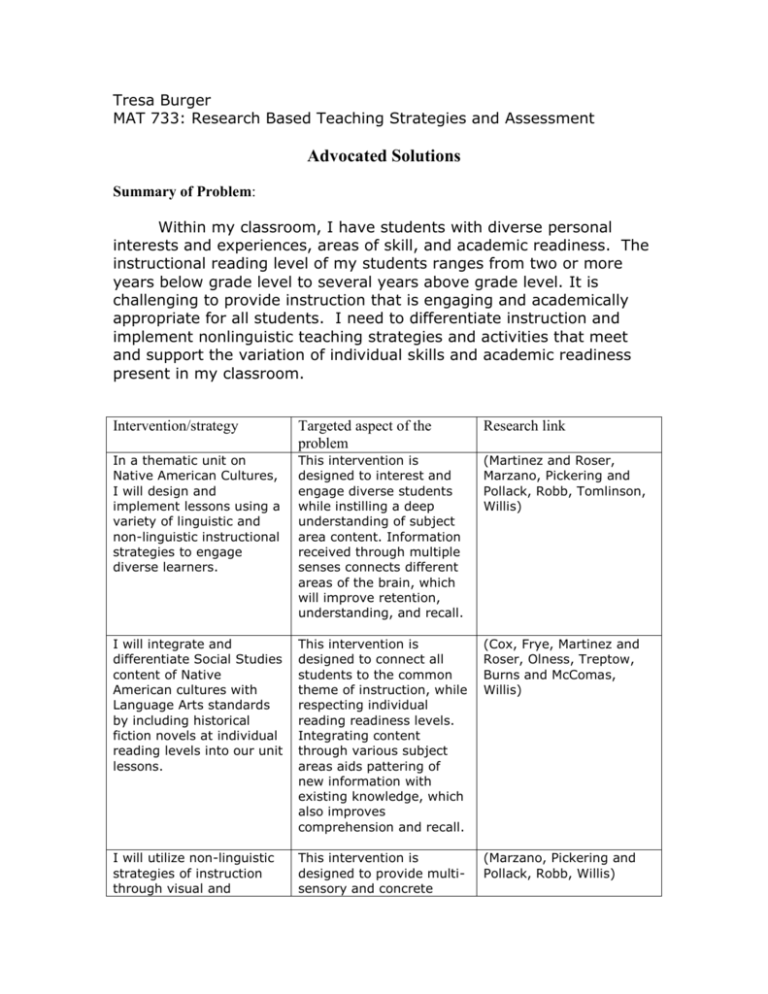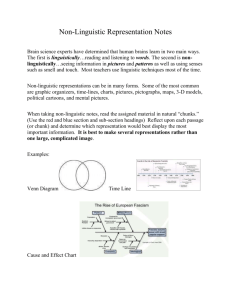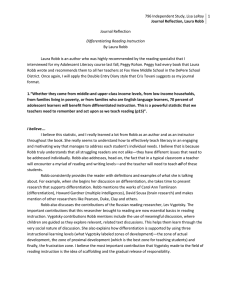File - Tresa Burger Professional Website
advertisement

Tresa Burger MAT 733: Research Based Teaching Strategies and Assessment Advocated Solutions Summary of Problem: Within my classroom, I have students with diverse personal interests and experiences, areas of skill, and academic readiness. The instructional reading level of my students ranges from two or more years below grade level to several years above grade level. It is challenging to provide instruction that is engaging and academically appropriate for all students. I need to differentiate instruction and implement nonlinguistic teaching strategies and activities that meet and support the variation of individual skills and academic readiness present in my classroom. Intervention/strategy Targeted aspect of the problem Research link In a thematic unit on Native American Cultures, I will design and implement lessons using a variety of linguistic and non-linguistic instructional strategies to engage diverse learners. This intervention is designed to interest and engage diverse students while instilling a deep understanding of subject area content. Information received through multiple senses connects different areas of the brain, which will improve retention, understanding, and recall. (Martinez and Roser, Marzano, Pickering and Pollack, Robb, Tomlinson, Willis) I will integrate and differentiate Social Studies content of Native American cultures with Language Arts standards by including historical fiction novels at individual reading levels into our unit lessons. This intervention is designed to connect all students to the common theme of instruction, while respecting individual reading readiness levels. Integrating content through various subject areas aids pattering of new information with existing knowledge, which also improves comprehension and recall. (Cox, Frye, Martinez and Roser, Olness, Treptow, Burns and McComas, Willis) I will utilize non-linguistic strategies of instruction through visual and This intervention is designed to provide multisensory and concrete (Marzano, Pickering and Pollack, Robb, Willis) kinesthetic representation of content, as well as hands-on construction of various Native American dwellings and artifacts. representation to aid students as they think about and recall new knowledge. My first advocated solution is to create and implement a thematic unit on Early Native American Cultures, utilizing both linguistic and non-linguistic instructional strategies. According to Robb (2008), and Frye (2009), organizing curriculum and instruction around a common theme is an effective way for teachers to be responsive to the various needs of students. By providing diverse materials and activities at individual instructional levels, all students are able to connect to the common theme of the lesson appropriately. Willis (2007) suggests that thematic approaches connect various subject areas, which help pattern new information with existing memories and knowledge, and therefore aids in comprehension and recall. Tomlinson (2005), recommends providing a variety of learning tasks that are academically challenging for individual students at appropriate readiness levels. To reach my goal of engaging all learners through linguistic and non-linguistic strategies, it is essential to plan and implement a variety of multi-sensory lessons and activities. In addition, I will need to prepare materials to address various academic readiness levels. My second advocated solution is to integrate Social Studies content with Language Arts standards by acquiring a variety of Native American historical literature at various reading levels. Frye (2009) suggests that optimal learning takes place when student challenges are neither too hard nor too easy. By providing students with academically appropriate levels of instructional material, students will be able to individually connect to the subject matter. (Robb, 2008) Integrating subject areas helps pattern new information with existing knowledge, making learning relevant and meaningful. (Willis, 2007) To reach my goal of successfully integrating Social Studies with Language Arts standards, it is necessary to assess individual student reading levels. I must also acquire content rich Native American historical literature at appropriate reading levels for the students in my class. My third advocated solution is to implement various nonlinguistic representations of content, through a variety of instructional strategies. Some examples are illustrations, power point presentations, interactive computer activities, and construction of 3-D models. By implementing a variety of instructional strategies, and offering more ways to explore and express learning, we are more likely to reach and connect with a wide range of students. (Tomlinson and McTighe, 2006) According to Willis (2007), student engagement increases with multi-sensory and thought-provoking experiences. Robb (2008) suggests that an effective way to encourage and promote learning is to provide a variety of multi-sensory activities and projects in which students may explore and demonstrate learning. Many of my students read two or more years below grade level, and therefore struggle to comprehend and perform well on traditional written classroom assignments and assessments. By providing a variety of avenues in which to acquire content and explore learning, I hope and expect to see and improvement in participation, comprehension, and performance. To reach my goal of incorporating non-linguistic student learning activities, it is necessary to evaluate and determine what kind of activities will extend and expand the knowledge and content of the unit. It is important that I develop projects and activities that address a variety of learning and sensory modalities to meet the diverse needs of all students. I must also determine an appropriate way to assess mastery of the lesson objectives. References Cox, S. (2008). Differentiated instruction in the elementary classroom. Education Digest, 73(9), 52-54. Frye, E. M. (2009). Integrating instructional-level social studies trade books for struggling readers in upper elementary grades. Illinois Reading Council Journal, 37(4), 3-12. Martinez, M. G., & Roser, N. L. (2003). Children’s responses to literature. In J. Flood, D. Lapp, J. Jenson, & J. Squire (Eds.), Handbook of research on teaching the English language arts (2nd ed.) (pp.799-813). Mahwah, NJ: Erlbaum. Marzano, R. J., Pickering, D., & Pollack, J.E. (2001). Classroom instruction that works: research-based strategies for increasing student achievement. Upper Saddle River, New Jersey: Prentice Hall. Olness, R. (2007). Using literature to enhance content area instruction: A guide for K-5 teachers. Newark, DE: International Reading Association. Robb, L. (2008). But they all read at different levels. Instructor, 117(4), 4751. Robb, L. (2008). Differentiating reading instruction: reaching all learners with best practice teaching. Differentiating reading instruction: how to teach reading to meet the needs of each student (pp. 11-30). New York: Scholastic. Tomlinson, C. (2005). How to differentiate instruction in mixed-ability classrooms. Upper Saddle River, NJ: Merrill/Prentice Hall. Tomlinson, C., McTighe, J. (2006). Integrating differentiated instruction and understanding by design. Alexandria, VA: ACSD. Treptow, M. A., Burns, M. K., & McComas, J. (2007). Reading at the frustration, instructional, and independent levels: the effects on students' reading comprehension and time on task. School Psychology Review, 36(1), 159-166. Willis, J. (2007). Brain-friendly strategies for the inclusion classroom: insights from a neurologist and classroom teacher. Alexandria, VA: Association for Supervision and Curriculum Development.






